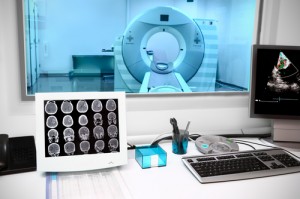MRI Spectroscopy May Improve Accuracy in Predicting MS Progression
Written by |

 A new study published this week in the Journal of the American Medical Association Neurology says that predicting disease evolution is becoming essential for optimizing treatment decision-making in multiple sclerosis (MS), in which pathologic damage typically includes demyelination, neuro-axonal loss, and astrogliosis.
A new study published this week in the Journal of the American Medical Association Neurology says that predicting disease evolution is becoming essential for optimizing treatment decision-making in multiple sclerosis (MS), in which pathologic damage typically includes demyelination, neuro-axonal loss, and astrogliosis.
The study, entitled “Magnetic Resonance Spectroscopy Markers of Disease Progression in Multiple Sclerosis” (JAMA Neurol. Published online first May 19, 2014. doi:10.1001/jamaneurol.2014.895), is coauthored by Sara Llufriu, MD, PhD of the Department of Neurology, University of California San Francisco and the Center for Neuroimmunology, Service of Neurology, Hospital Clinic and Institut Investigacions Biomdiques August Pi i Sunyer (IDIBAPS) at Barcelona, Spain; John Kornak, PhD, of the Department of Epidemiology and Biostatistics, U.C. San Francisco; Helene Ratiney, PhD, Don Brenneman, BA, Bruce A. Cree, MD, Mehul Sampat, PhD, and Stephen L. Hauser, MD, — all of the Department of Neurology, U.C. San Francisco; Joonmi Oh, PhD, and Sarah J. Nelson, PhD of the Department of Radiology, U.C. San Francisco; and Daniel Pelletier, MD, of the UCSF Departments of Neurology and Radiology and the Departments of Neurology and Diagnostic Radiology at Yale University, New Haven, Connecticut.
The study’s objective was to evaluate potential of magnetic resonance markers of central nervous system injury for predicting brain-volume loss and clinical disability in MS.
Study participants were selected from the Multiple Sclerosis Center at the University of California at San Francisco, and the preliminary data set included 59 patients with MS and a control group of 43 healthy individuals. The study’s confirmatory data set included 220 patients from an independent, large genotype-phenotype research project.
The scientists found that baseline N-acetylaspartate (NAA) level, myo-inositol (mI) in normal-appearing white and gray matter, myelin water fraction in normal-appearing white matter, markers of axonal damage, astrogliosis, and demyelination were evaluated as predictors in a preliminary data set. Potential predictors were subsequently tested for replication in a confirmatory data set. Clinical scores and percentage of brain-volume change were obtained annually over four years as outcomes. Predictors of outcomes were assessed using linear models, linear mixed-effects models, and logistic regression.
The research team reports that N-acetylaspartate and mI both had statistically significant effects on brain volume, prompting the use of the mI:NAA ratio in normal-appearing white matter as a predictor. The ratio was a predictor of brain-volume change in both cohorts, and furthermore, they note that the mI:NAA ratio predicted clinical disability in the preliminary data set and predicted Multiple Sclerosis Functional Composite evolution in the confirmatory data set. Myelin water fraction did not show predictive value.
[adrotate group=”4″]
The researchers conclude that the mI:NAA ratio in normal-appearing white matter has consistent predictive power on brain atrophy and neurological disability evolution, and that the combined presence of astrogliosis and axonal damage in white matter has cardinal importance in disease severity.
In an accompanying editorial titled “A Possible In Vivo Marker of Disease Progression for Multiple Sclerosis?” David H. Miller, MD, of the Department of Neuroinflammation at the University College London Institute of Neurology, London, England, notes that since MS is a common, chronic neurological disease with a highly variable prognosis and clinical course, there here is a pressing need for reliable predictors of future disease course — not only for individual patient counseling, but also because there are now disease-modifying treatments that favorably modify the early relapsing-remitting phase of the disease. It is obviously desirable to know for whom such treatments are most needed and useful.
Dr. Miller observes that magnetic resonance imaging (MRI) provides useful prognostic information in relapse-onset MS, and that for patients presenting with a clinically isolated syndrome suggesting demyelination, observation of the presence of clinically silent MRI lesions characteristic of demyelination is highly predictive of future relapse, leading to a diagnosis of clinically definite MS. He notes that MRI lesion features are now included in criteria that enable earlier diagnoses of MS, and that presence of active lesions on serial MRI is associated with higher clinical relapse risk in relapsing-remitting MS, and that strong group-level correlation is observed between treatment-associated decreases in relapses and active lesions in controlled clinical trials.
The main focus of the Department of Neuroinflammation at the University College London Institute of Neurology is on multiple sclerosis , with a broad range of research from basic neuroscience to clinical translation, including therapeutic trials. Important collaborations exist with other departments in the Institute, in UCL, and beyond. The research is supported by programme grants from the MS Society and Wellcome Trust, and multiple project grants and industrial contracts.
Sources:
Journal of the American Medical Association Neurology





